Gamping Gear List
Core Items
Of all the items in your camping gear list, the core set are those that are absolutely essential to your well-being. These items are so important that it's wise to have a back-up item that can be used in an emergency the original is lost or damaged. My core items are:
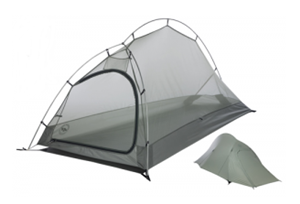
- Tent: essential because it's what keeps you warm, dry and clean. I recommend the lightest double-wall tent you can find. Avoid single wall tents, which have problems with condensation. I use the BigAgnes SL1 one-person tent (pictured), which weighs only 1.2 lb. Choose a tent with a color that blends into the forest and don't have a high profile. Backup-item: emergency blanket (tarp) and cord.
- Sleeping pad - a soft material to place under your sleeping bag. Essential because it's allows you to sleep comfortably and keeps you insulated from the cold ground. I use a short-length self-inflating Thermarest, which is extremely compact and light when rolled up. Backup-item: piece of bubble wrap.
- Sleeping bag: essential for keeping you warm at night. I use a slightly undersized goose-down bag, which is amazingly light and warm. Backup-items: thermal underwear, polar socks, toque.
- Portable water filter: essential for filtering drinking water from creeks and still water sources. I've used the MSR Hyperflow Microfilter (super light) and the and the Katadyn Hiker Pro (slightly heavier, but easier to maintain) with good success. Backup items: water purification tablets, aluminum pot for boiling water.
- Backpack: I bought the lightest expedition-size pack I could find. I recommend having a large-enough pack that you can place all your items inside without resorting to tying anything to the outside. Anything on the outside will get wet in the rain, and your backpack will be much easier to transport through airports if everything fits inside.
Clothing
- lightest pair of rip-stop nylon pants you can find. (1-2 pairs) Extra pockets are good. Pockets with zippers are even better.
- lightest, thinnest short sleeve shirts you can find that are fast-drying (2)
- underwear (3-4 pairs)
- thin, short cotton socks (~4 pairs). I find that Haynes cotton socks are resistant to smelling awful after prolonged use.
- ultra thick, regular length polar socks (1 pair)
- bathing suit - if you're a guy, choose something that can double as a pair of shorts.
- long underpants made from fleece or microfiber (as warm as possible).
- long sleeve wool/blend undershirt, with neck protection (as warm as possible).
- water-resistant and wind-breaking jacket, with a hood. Should be light, but tough enough to withstand thorny bushes (eg. wading into a blackberry bush).
- fleece jacket, long sleeves. Should be able to wear this as a layer underneath your wind-breaker.
- toque (to wear while sleeping - keeping the head warm is the easiest way to keep the whole body warm).
- mesh cap with visor (mesh blocks enough of the sun to prevent sunburn, and allows enough airflow to keep you from sweating on the hot days)
- shoes: light shoe with Gortex for water resistance. Be very careful to avoid shoes that have thinner soles; the more cushioning between you and the ground the better. Backup-item: crocs or flip-flops (excellent for wading into rocky beaches). Avoid traditional leather hiking boots, which are far too heavy.
Tip: Be sure and take at least one item of clothing that is dark black, so you can build a solar shower (described below).
Utility Gear
- waterproof backpack-cover with drawstring. This cover can protect the backpack from rain, but particularly useful when travelling through airports. The cover prevents all the straps and loose ends from getting snagged on the luggage conveyor belts and also keeps it clean. I picked up an inexpensive one at MEC.
- folding tree-saw: looks like an oversized switchblade knife, with serrated teeth for sawing through wood (pictured). Very handy for clearing an area of vegetation for your tent. It's particularly useful for removing thorny bushes and cutting out roots. Backup-item: knife.
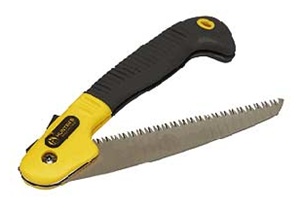
- plastic bags: lots of them, with different colors and sizes, including ziplock bags, fishnet bags with drawstrings, and a light cloth grocery bag.
- grocery bag ties: unpredictably useful.
- large plastic ice-cream pails with lids (2). They should be able to nest within each other. Use them as rodent-proof food containers. Also see the section on refrigeration.
- spare shoelace
- disinfectant (eg. polysporin) and/or antibacterial gel
- superglue - mini four-pack of dollar-store superglue. Dual use: can be used to permanent tent repair and also used to close larger cuts quickly and safely
- thin, light cord.
- inflatable neck pad for sleeping on bus/plane: dual use as pillow. Place within backpack cover with other clothes to make a large pillow.
- earplugs - easy to lose, so take a backup set.
- prescription swimming goggles. The ocean water is usually too cold for swimming but one the rare occasion that it's not, it's a treat to explore the reefs. dual use: if I lose or break my glasses, I can wear the swimming goggles and be able to clearly see everyone laughing at me.
- fishing tackle (several jigs, clips, line, small ball weights).
- sticky notes, pen: for making maps while bushwhacking and leaving notes on my tent.
- headlamp with extra batteries (pictured). I recommend a headlamp that has at least two settings: a broad low-intensity beam that you can use for long periods (eg. reading) and a more focused high intensity beam for walking around at night. Backup-items: extra batteries, keychain led, matches, lighter.
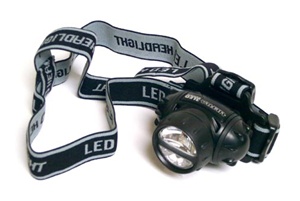
- keychain led: dollar-store led light, doesn't give off a lot of light but weighs almost nothing, a good backup light source.
- chemical lightstick: dollar-store item that's not a necessity. I took this to experiment with night-fishing. And exploring the mines of Moria.
- sharpening stone: take something for sharpening your knife. Watch a youtube video to learn the proper technique. Even poor technique is better than a blunt knife.
- bug spray (small): rarely used item. Long pants and long sleeves are typically enough protection from insects. Mosquitoes are not a huge problem on the islands.
- lighters and matches: I find small lighters to be more useful than matches, but carry both. Matches can and do get damp, and even so-called waterproof matches usually don't work well in damp conditions.
- tent-patches: the inner wall of my tent had some extra material that was forming a pocket. I cut that material off and kept it for doing patching work, with superglue.
- needle and thread: not essential.
- pullapack: this is an ultralight aluminum contraption I built myself. It's used for pulling my backpack around behind me rather than carrying it, such as when I am in the city. it disassembles to fit inside the backpack when not in use, and weighs only 1.3 lb.
- gloves: sometimes I take two pairs, if I can't find one pair of high quality. Essential for cooking and scrambling up and down difficult terrain.
- knife: I recommend a light folding knife, since you will be using your tree-saw for any serious work. I have a wood-handled Opinel knife (pictured), and use it for cooking/eating, cleaning fish, and other random tasks.
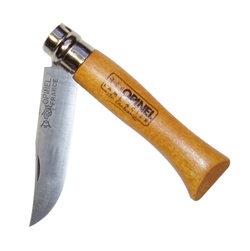
- small umbrella - a new item for me, but one I will take again. In rainy conditions, having a small umbrella is preferable to relying exclusively on rain gear. Also provides protection from the sun (if you're a sissy!)
- emergency blanket (thin plastic sheet, silvered on one side). It is marketed as a way to keep warm in emergencies but it's generally useful as a lightweight tarp. In cold conditions you can cover the tent with the silver-side facing inward to trap heat, and in sunny and hot conditions cover the tent with the silver-side facing outwards to reflect the sunlight and keep the tent cool.
- bubble wrap: a single sheet of the common plastic packaging material, consisting of small air-filled plastic bubbles. Handy to have around camp when you want to sit or lay down on damp, dusty or hard ground. Dual use: backup sleeping pad.
- microfiber facecloth. This dollar-store item dries fast; you can wash it by hand in any sink and squeeze it almost dry. No need for a full-size towel.
- whistle: If you are travelling solo and fall or injure yourself unexpectedly, a whisle will carry a lot further and last a lot longer than your voice.
Medical Kit
- bandaids - dual use: bandaids are also great for making quick tent repairs, such as patching small holes from nibbling mice.
- disinfectant (eg. polysporin, anti-bacterial gel). You never know when you're going to be cut.
- medical gauze: for wrapping serious cuts.
- clothespins - dual use: can be used for securing gauze as well as removing slivers.
- pillbox: aspirin, anti-diuretic, sleeping pills (non-prescription melatonin), decongestant.
Bathroom Kit
- ultralight portable electric shaver: I use this for shaving my head and trimming beard. Looking unkempt can cause you all kinds of grief. Island locals treat you with less suspicion if you are shaven and clean cut, and it's easier to get a lift.
- 3 gillette blades.
- travel size shaving cream.
- small mirror, used mostly for shaving (of course can be used to reflect the sunlight to a search helicopter, happens all the time!)
- sawed-off toothbrush with bristle protector to keep it clean(ish). I avoid the travel-sized toothbrushes because they have smaller bristles, and less of them. Why is my toothbrush sawed-off? Because otherwise it's too damn heavy!
- travel-size toothpaste
- small dental floss.
- 1/2 roll toilet paper. This is not really necessary to pack, as long as you pick up extra tissue whenever you visit a public washroom.
- small nail clippers.
Cooking Gear
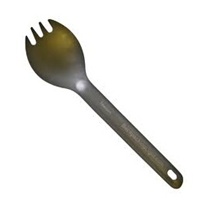
- Bush Buddy wood-burning stove (see Fire and Cooking)
- aluminum cooking pot (1)
- knife (described previously) (1)
- spork: a spoon with fork-like tips (pictured). Mine is made of titanium (it's important that your spork be able to survive a plane crash).
- plastic bottles (supermarket water bottles). Water bottles can be purchased once you are close to your destination, they are essential for storing water and for solar heating your water for taking showers. In the unlikely event that you lose or damage your aluminum pot and still insist on boiling water, it's possible to suspend a plastic bottle over a fire and boil water in it (the water keeps the plastic from melting).
- aluminum plate (1). Also acts as cover for the cooking pot.
|





